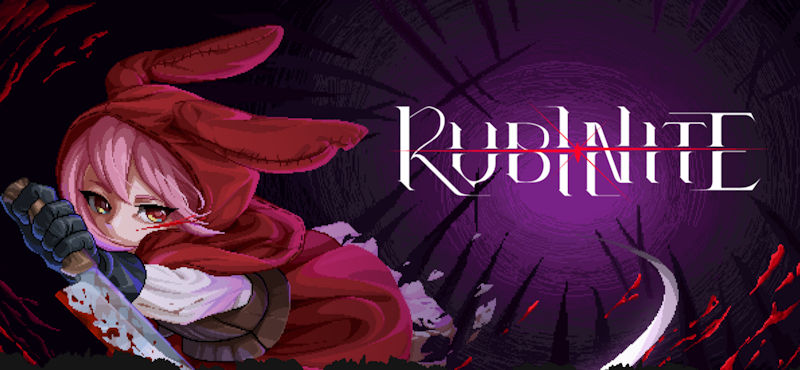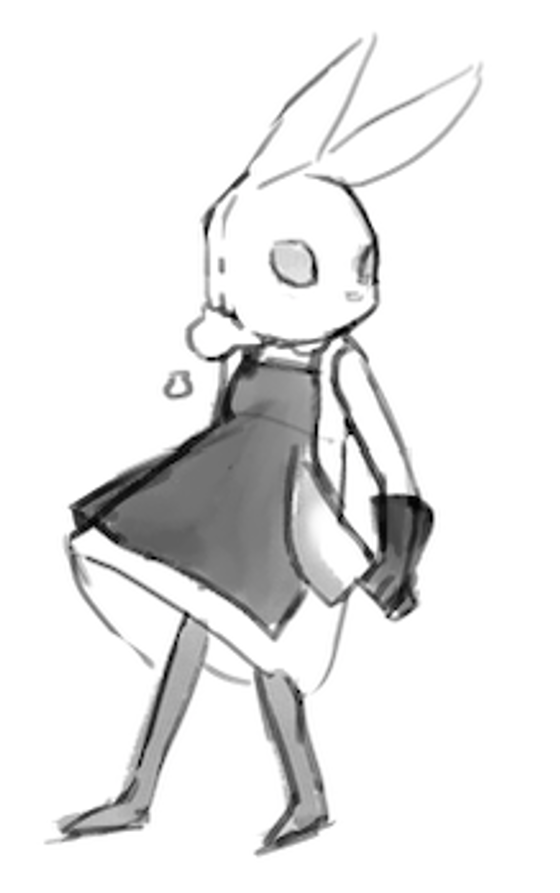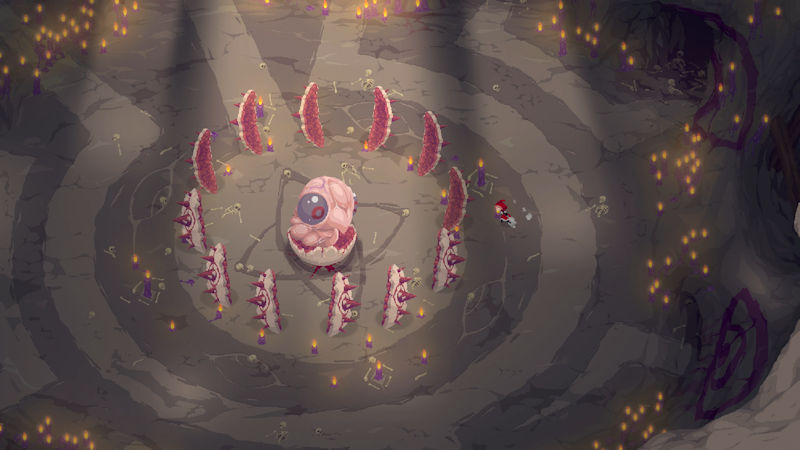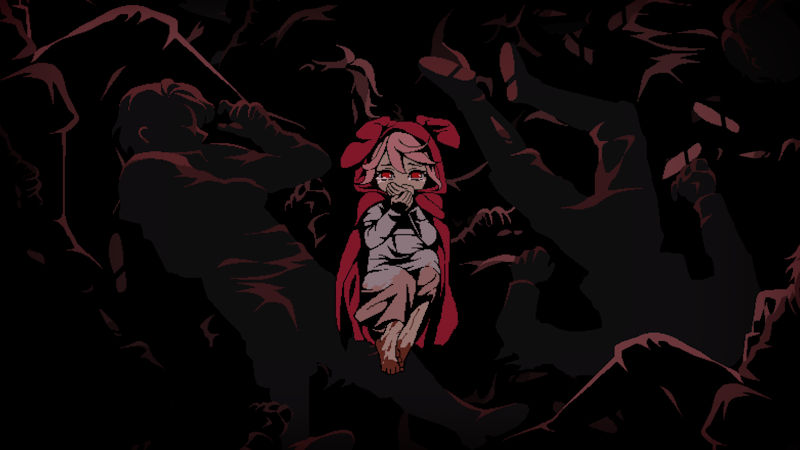
Written by Jared T. Hooper on 22 Nov 2024
Cup Dog Games is an upstart four-man studio that released the demo for their debut title Rubinite, a 2D Souls-like boss rush, back in September, and we had the privilege and delight of speaking with the team and learning about their design approach and development process, how the team formed, and we even got our hands on a piece of unpublished concept art.
---

Where did the idea for Rubinite come from? Where did you draw your inspiration from?
The core mechanics of Rubinite were primarily inspired by Titan Souls. Additionally, the combat system draws influence from Sekiro: Shadows Die Twice and Dark Souls III. We were deeply fascinated by the concept in Titan Souls where players can observe the enemy’s heart and deliver a critical strike. This inspired us to design a game in a similar direction.
However, while the one-hit-kill mechanics of Titan Souls are intriguing, they also limit the potential for development in each battle. At the same time, we loved the combat systems of Souls-like games, so we began exploring the possibility of creating a game that preserves the essence of Titan Souls while incorporating combat mechanics that are closer to the Souls-like style. This idea eventually led to the initial concept for Rubinite.
How did you come up with the concept and design of Ruby?
We started conceptualizing the protagonist and her backstory after finalizing our core combat mechanics. Initially, Ruby wasn’t a princess wearing a rabbit-ear cloak; she was a hunter with a realistic rabbit head. (Looking back now, the realistic rabbit head was quite a terrifying design—haha!) [Below is an] unreleased early sketch:

The choice of a rabbit as the character’s motif was inspired by Hollow Knight. The Knight in Hollow Knight has a highly memorable silhouette, defined by its large stag beetle horns. We aimed to create a similarly iconic and charming character, and a rabbit felt like the perfect fit with its distinct and endearing traits.
Once we settled on the visual direction, we integrated the character, story, and combat mechanics. We moved away from the realistic rabbit design and opted for a cute, youthful girl. And so Ruby was born—a girl with the ability to see the cores inside monsters, a gift that makes her the only hero capable of defeating them.
I likened the combat to a matador fight in my article. How did you come up with this system of waiting on the opponent and dodging their attacks to power up Ruby?
As I mentioned earlier, we wanted to create a blend of Titan Souls’ mechanic of identifying the enemy’s heart with Souls-like combat systems. To achieve this combination, our first step was to abstract the process of locating the enemy’s heart. We introduced a mechanic where players can use a single button to focus and identify the core weak points of enemies, which led to the creation of the Focus system.
Next, we thought about how players could “release” what they accumulated through focusing during combat. One of the most enjoyable elements in action games is the moment when the player and enemy pass each other, crossing paths. In Dark Souls, this is achieved through rolling and dodging enemy attacks. This made us think, why not intentionally create more opportunities for such moments? That’s how we came up with the Critical Strike mechanic, allowing players to pierce through the enemy’s core once its weak point is identified. At this point, the core system was established.
To enhance the risk-and-reward experience, we introduced a feature where players can accumulate up to three marks, but taking damage causes them to lose all progress. However, we soon realized that simply standing still and observing the enemy could slow down the pacing of the game. This led us to another concept: "Openings often appear when the enemy is attacking." We were inspired by Sekiro: Shadows Die Twice, where the precision of reacting to enemy attacks is crucial.
So, we decided that since Ruby is in a state of observation, she should be able to instantly see through the enemy’s weak point during the moment of their attack. This led to the Perfect Dodge mechanic, where dodging at the right moment not only completes the observation but also instantly accumulates marks.
How did you come up with your boss designs and how their battles play out?
Our boss designs are primarily focused on the combat experience itself. We first create a complete battle using a blocky prototype character (which we affectionately refer to as the "tofu man"), and once the combat mechanics are set, we then design the boss's appearance. After all, Rubinite is fundamentally an action game centered on combat, and ensuring the gameplay is fun is our top priority. As for the design inspiration, aside from the character backstories conceived by the producer, the rest of the artistic details were all designed by our lead artist.
How come you decided to make this game a boss rush?
We decided to make Rubinite a boss rush game not only because we were inspired by Titan Souls, but also because our team didn't have much experience in game development at the time. We wanted to choose a project with a smaller scope as our starting point. Additionally, we wanted to focus more on refining each boss fight, rather than spreading our efforts across many smaller, less polished enemy encounters.

What sort of experience are you hoping players have with your game? What emotions and thoughts do you want crossing their minds?
One of our main goals was to create a combat system that stands out from other action games. We wanted players to feel a unique experience, one that emphasizes the intense confrontations between bosses. When Ruby is focusing on the enemy, you’re also focused, completely immersed in that moment!
When players defeat a boss, we want them to feel that victory wasn’t because their character leveled up or because they wore stronger gear. Similar to the feeling we got from Sekiro, the win comes because you, as a player, have truly grown and mastered the challenge. At that moment, you become Ruby.
As far as the story of Rubinite goes, how much emphasis does that receive? Is there a full tale you want to tell, is it a matter of gameplay convenience, or something else?
The story of Rubinite is an essential part of the game. It doesn’t just serve the gameplay design—it’s also the foundation for Ruby’s adventures in this world and the story behind it all.
Who's in charge of the story? Is this story something they've wanted to tell for a while, or was it drafted specifically for Rubinite?
I, the producer, am responsible for the story design. The story of Rubinite has evolved alongside the game’s development. Initially, it was created simply to connect the game levels smoothly. However, as development progressed, I began to want to convey something deeper—Ruby’s choices, the truth behind the story, and a tale that players can truly enjoy. While Rubinite is fundamentally an action game, we’ve worked to ensure that the storytelling complements the gameplay, allowing both to enhance each other.
Were there any challenges you faced while creating Rubinite? How about things that went swimmingly?
We’ve always wanted to create a game with gameplay that hasn’t been seen in the market before, and that goal also became our biggest challenge, as we worried about how the market would receive it.
During the early development stages, we participated in many small indie game events, where we received a lot of positive feedback, but there were still many areas for improvement. As we continuously improved and refined the game, even with market research and adjustments, facing the global market when we launched the Steam demo felt completely different.
Two weeks before the demo release, we had domestic developers help us with internal testing. Rather than worrying about gameplay flow or bug fixes in the leaderboard, our biggest concern was whether players around the world would enjoy this kind of game mechanic. We constantly thought, "Is what we think is fun actually fun?" With the great spread of our demo trailer on YouTube, we didn’t want to disappoint the players supporting us. The pressure during that time was intense, to the point where the producer could barely sleep for three hours a night (there was even a moment when the stress led to some wild design ideas, thankfully stopped before they were implemented…).
Fortunately, a friend in the industry encouraged us, and we bravely released the demo. Afterward, the positive feedback from players really lifted a huge weight off our shoulders.

How exactly are you using market research and data to aid in the development in Rubinite?
We mainly use the language distribution of competing titles and data from our Steam backend to identify Rubinite's target markets. However, not much of the game's content is directly influenced by these numbers. Instead, we focus more on drawing inspiration from successful design examples we admire, combining them with our own creativity to shape Rubinite's unique design.
Your webpage for Rubinite says your team formed when four college graduates met during what sounds like an award ceremony. Would you care to elaborate on that story?
Yes, we’re happy to share that story!
The four of us come from three different universities (in fact, one of us didn’t graduate—he chose to pursue game development because making games made him happier than studying! laughs). We all majored in multimedia design-related fields. In Taiwan, the multimedia design department leads to various career paths, such as animation, gaming, and the film and television industries. Every multimedia design department across Taiwan participates in a national exhibition and competition called Vision Get Wild at the end of their studies. All students start working on their final projects in their third year, aiming to participate in the competition and earn recognition in their fourth year.
The four of us happened to win the silver and bronze awards in game design, and the gold award in planning at Vision Get Wild. It was through this event that we met each other and realized we were all on the same page. We thought, why not work together to make games after graduation?
And that’s how Cup Dog Games was born.
Would you like to briefly introduce your team members and their given roles in this project?
Our team consists of four members:
Wei-Sheng Liao: Producer, Lead Programmer, Planner, Combat Designer
Li-En Chen: Animator, Combat Designer
Yi-Xuan Song: Lead Artist (Character Design, Environment, Visuals)
Pace Lin: Assistant Artist, Assistant Programmer
In addition, we also have external collaborators, including partners for art, music, sound effects, and translation.
How long has Rubinite been in development?
We have been working on Rubinite for about 3 years.
How did you come up with your team name, Cup Dog Games, and how did you come up with the logo, which cleverly integrates the first letters of the name, C, D, and G?
The name Cup Dog actually has a bit of a silly origin XD. The pronunciation of Cup Dog in Chinese sounds like "Bagel," and we thought Bagel sounded really cute. Later, we decided to keep the same sound but change it to two different words, and that’s how Cup Dog Games came about.
As for the logo, it was simply created by our lead artist based on the concepts of Cup and Dog. It was just a casual sketch that turned out to be a clever way to incorporate the first letters of our team name: C, D, and G.
Based on in-game text, I'm guessing your team is based in China? The game also contains language support for Japanese and, of course, English. Do you have team members knowledgeable in those languages, or did you hire translators because you have a goal for making this game available in those languages as well?
As mentioned earlier, we are based in Taiwan. Our current plan is to support several languages, including Traditional Chinese, Simplified Chinese, English, Japanese, Korean, Russian, and Portuguese. The decision to prioritize these languages was mainly based on our wishlist data, but we may adjust this list as needed, especially after the demo was released, as many players have inquired about other language support.
For the demo, we currently support only Traditional Chinese, Simplified Chinese, English, and Japanese, as these are the languages our team members can read and write. Due to development time constraints, we were unable to add more languages. While we did use AI-assisted translations alongside our own, we acknowledge that there may still be some gaps compared to native speakers. As such, we plan to hire a professional translation team to review and refine the translations for all languages.
All of your mentioned inspirations come from either English or Japanese studios. Has Taiwanese culture had any influence on the world or design of Rubinite?
Haha, to be honest, we didn’t intentionally incorporate Taiwanese culture into our designs. However, it’s undeniable that our personal lives and experiences might have naturally influenced the development process to some extent.
Will there be any secrets or big moments you're hoping to surprise players with?
Yes.
The release date on the Steam page says 2025, but do you have a specific date in mind or a goal you're hoping to achieve?
Our original plan was to release in Q3 of 2025, but it may be adjusted depending on the development progress, as we are always facing unexpected situations and delays.
Even though the finish line for Rubinite is still a ways away, does your team have any plans once the full game's available?
Currently, we are focused on Rubinite’s development and planning. Aside from preparing for multi-platform releases, we don’t have additional plans yet. However, our team intends to continue creating more games in the future.
Do you have any final words or messages for players and potential fans?
After releasing the demo, we've received an overwhelming amount of support from players, whether through demo reviews, YouTube comments, Discord, or various community forums. Many players have even sent us emails expressing how much they enjoy Rubinite. These messages have been an incredible boost for us. We will continue moving forward with everyone's expectations in mind, aiming to create the best game possible. Until then, please continue to support us! Thank you so much!
---
If you want to keep abreast of Rubinite news, you can follow Cup Dog Games on their Twitter, Facebook, or Instagram, and you can even chat with fellow Rubinite fans across the globe on their Discord.
We thank Cup Dog Games for their time and patience with talking to us in what turned out to be their first-ever fully English interview, and we're looking forward to the full release of Rubinite.

Just writing about the video games that tickle my fancy when the fancy strikes.
posted by on 19 Dec 2025
posted by Ross Liversidge on 27 Nov 2025
posted by Ross Liversidge on 21 Nov 2025
posted by Ross Liversidge on 16 Oct 2025
posted by Ross Liversidge on 14 Oct 2025
posted by Ross Liversidge on 10 Oct 2025
posted by Ross Liversidge on 30 Sep 2025